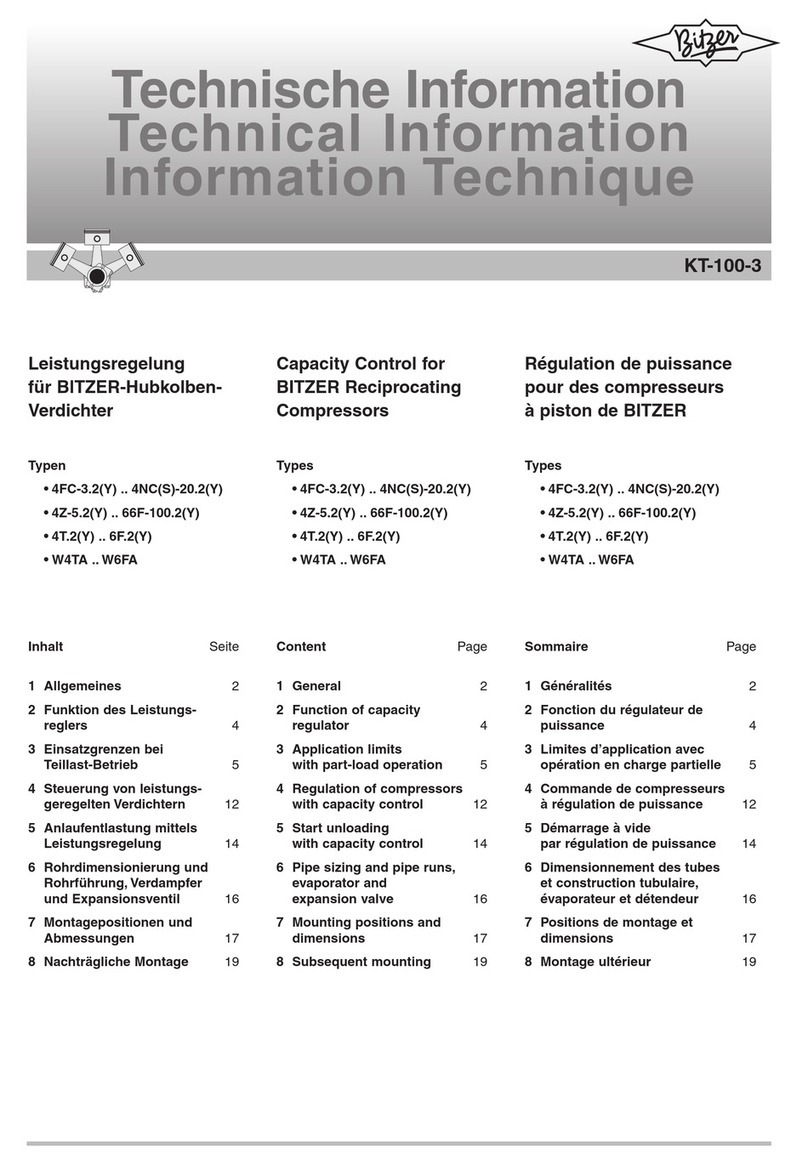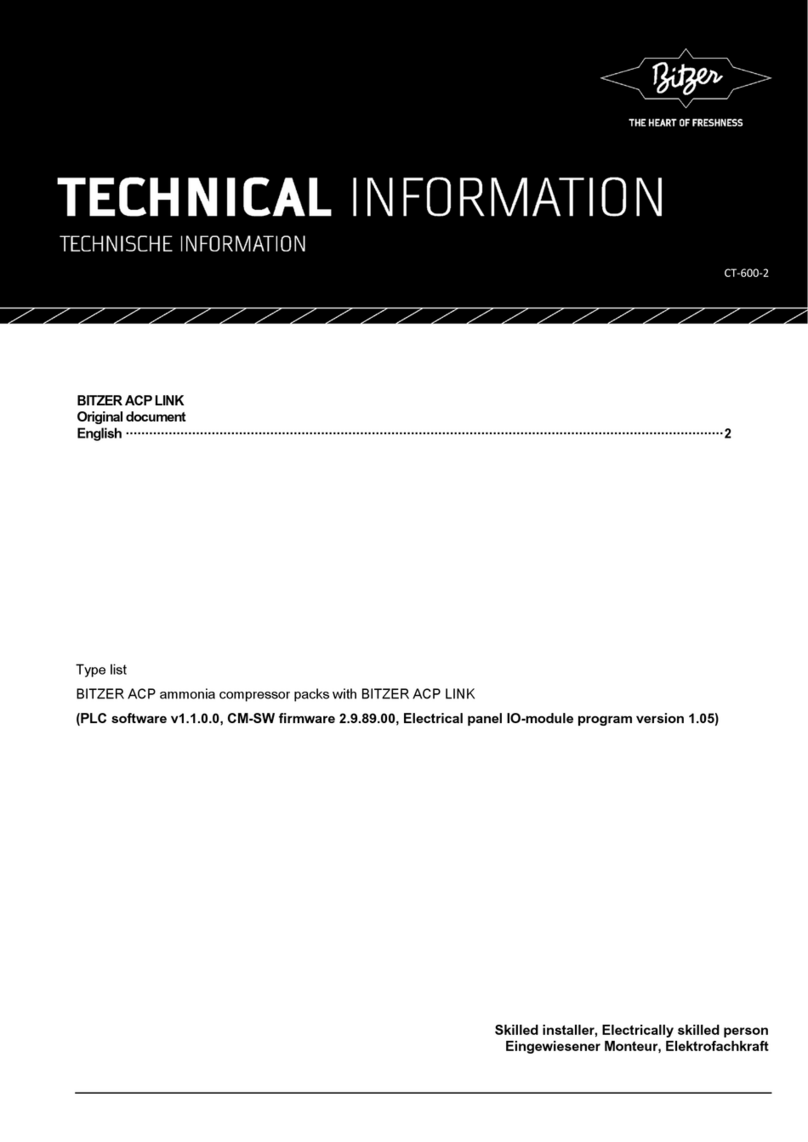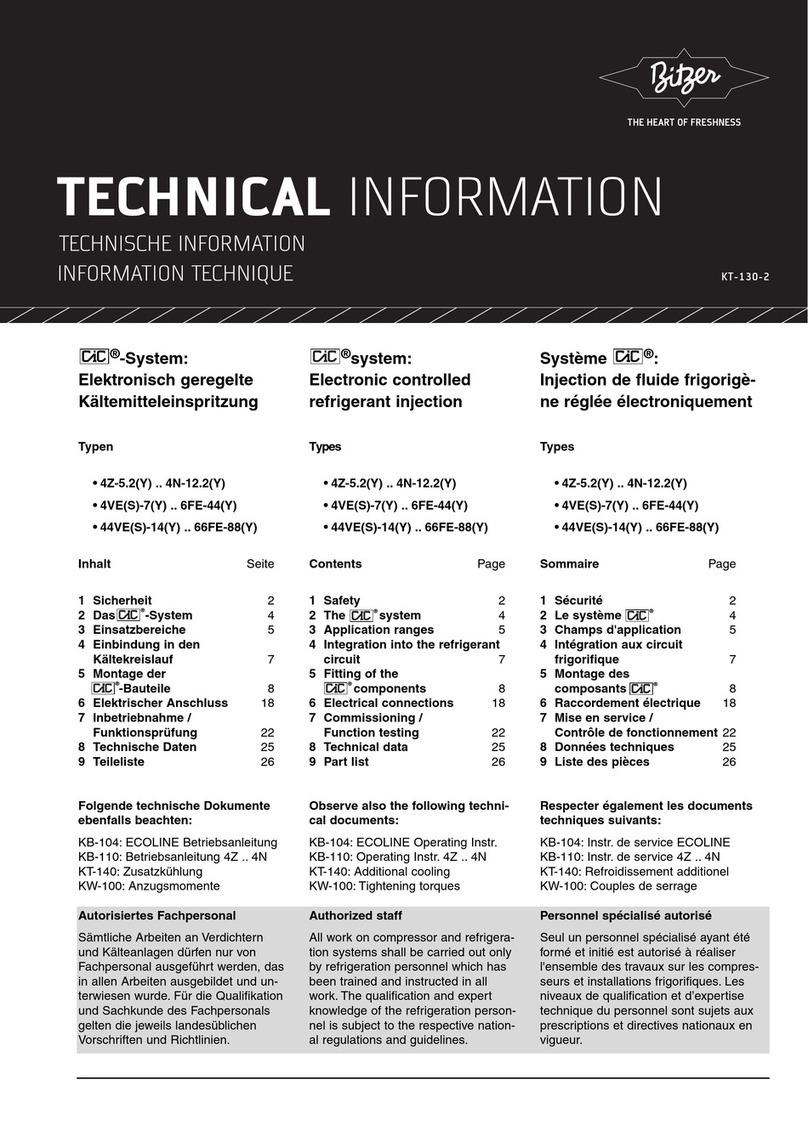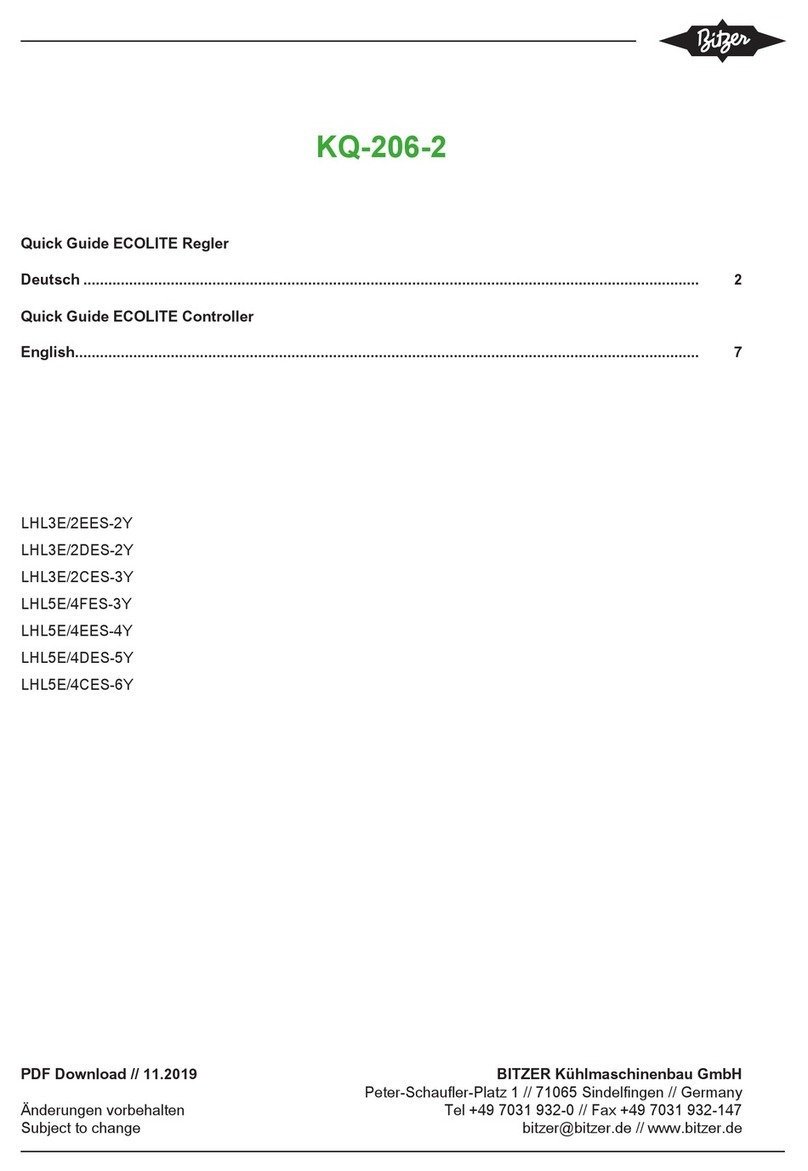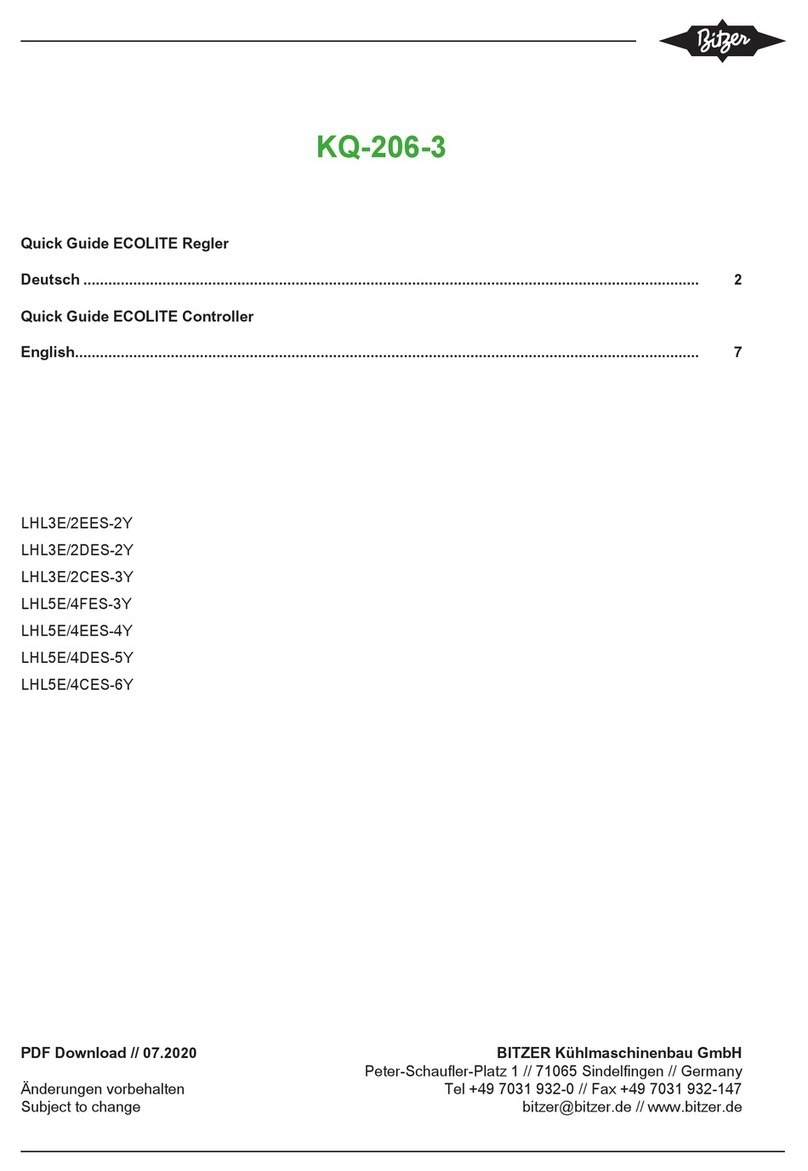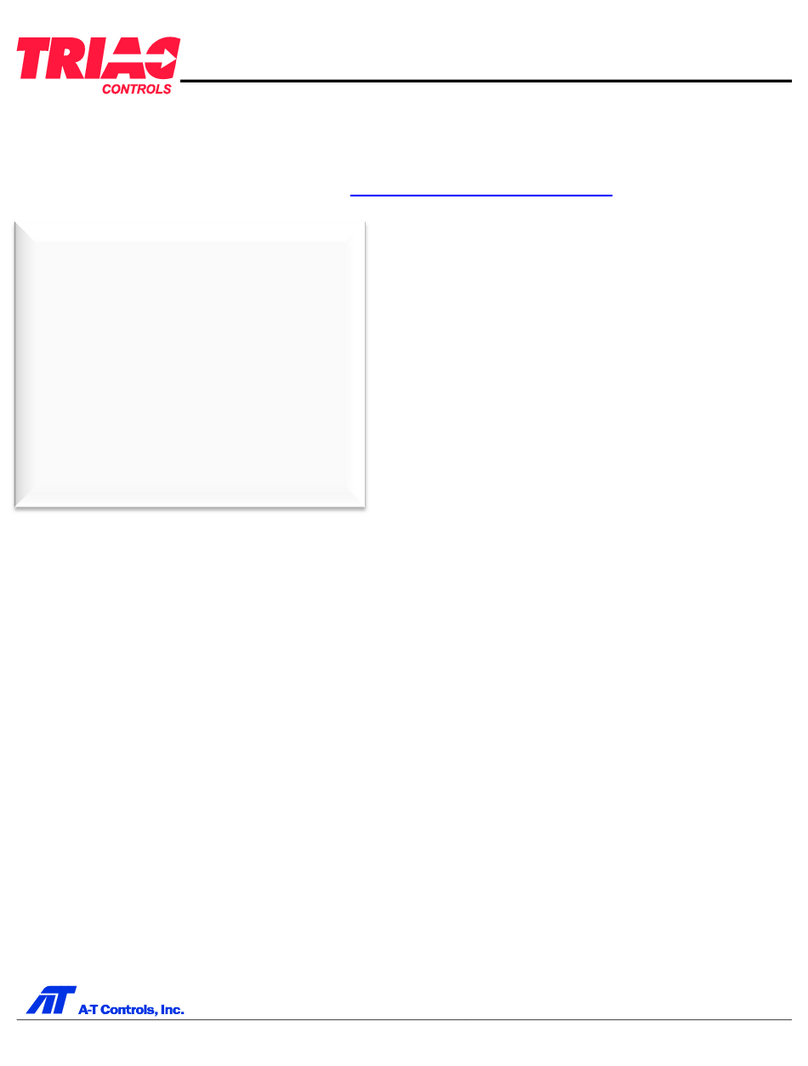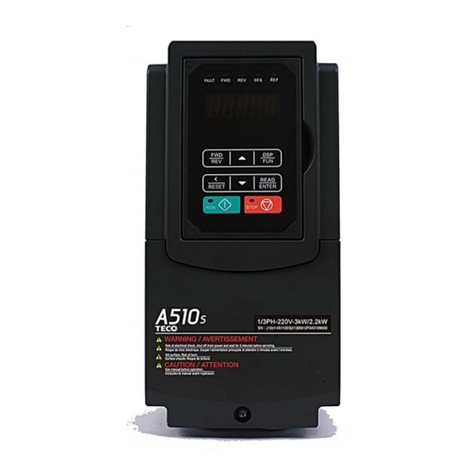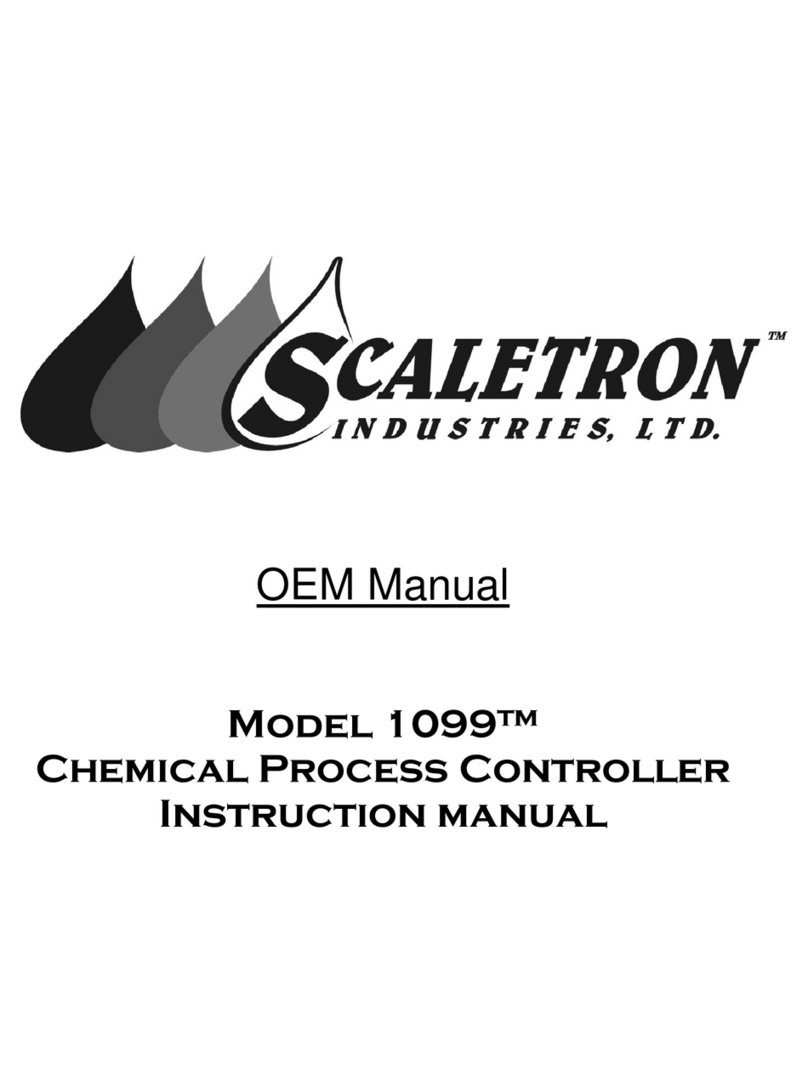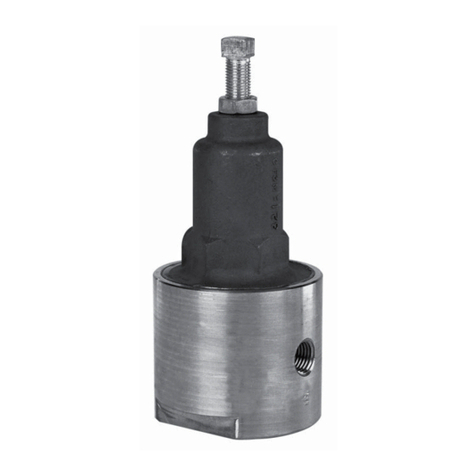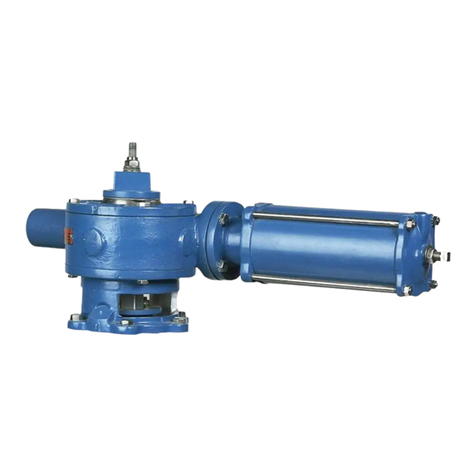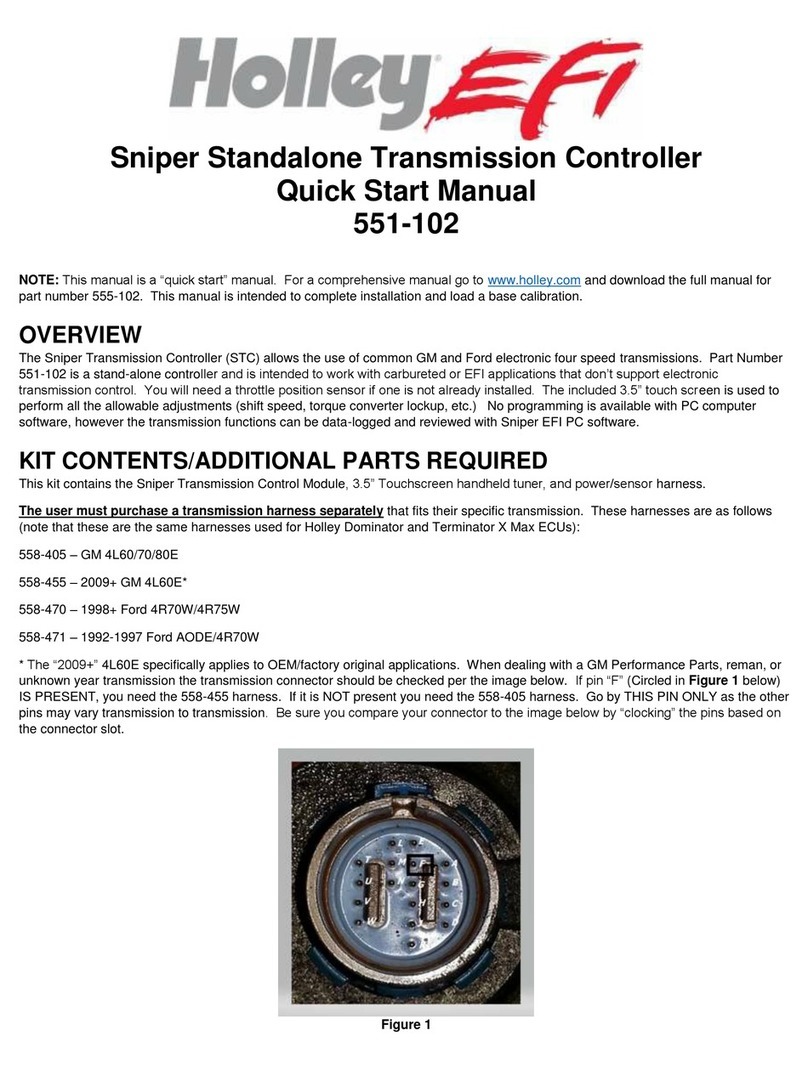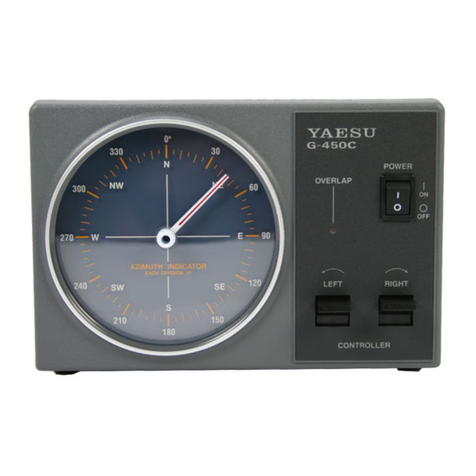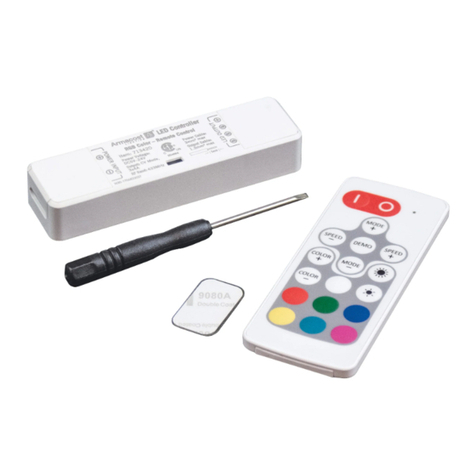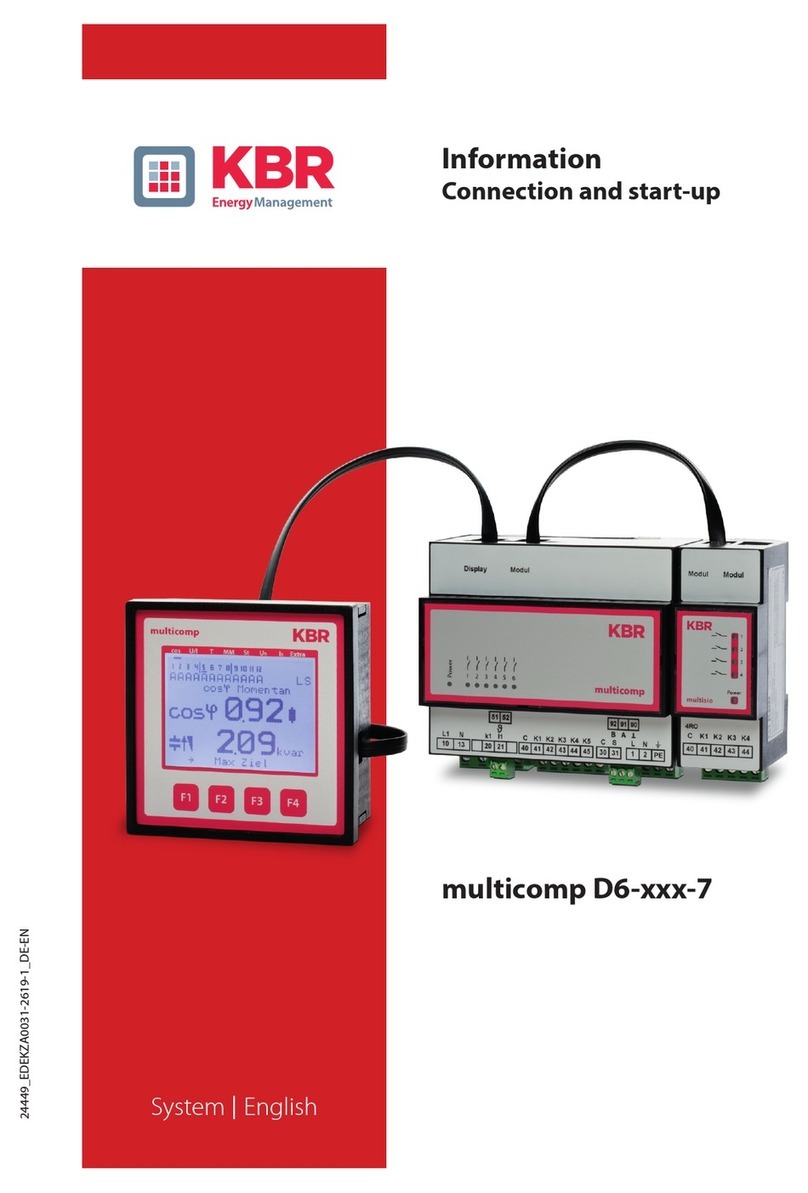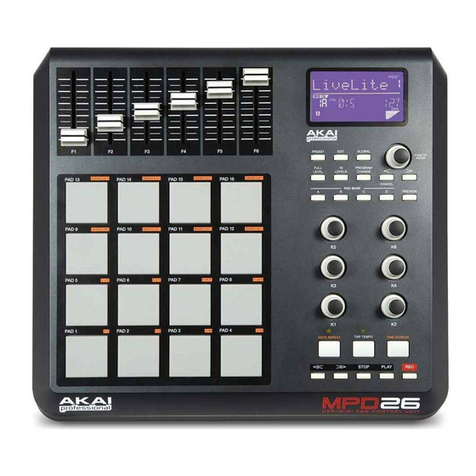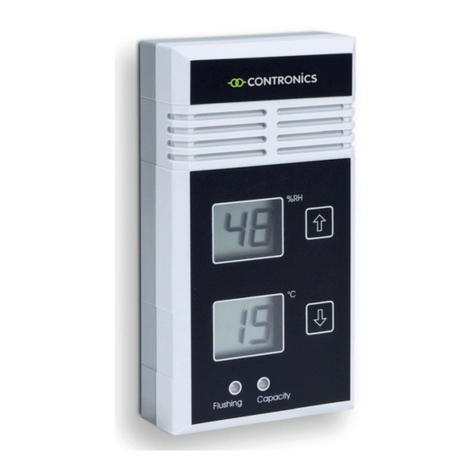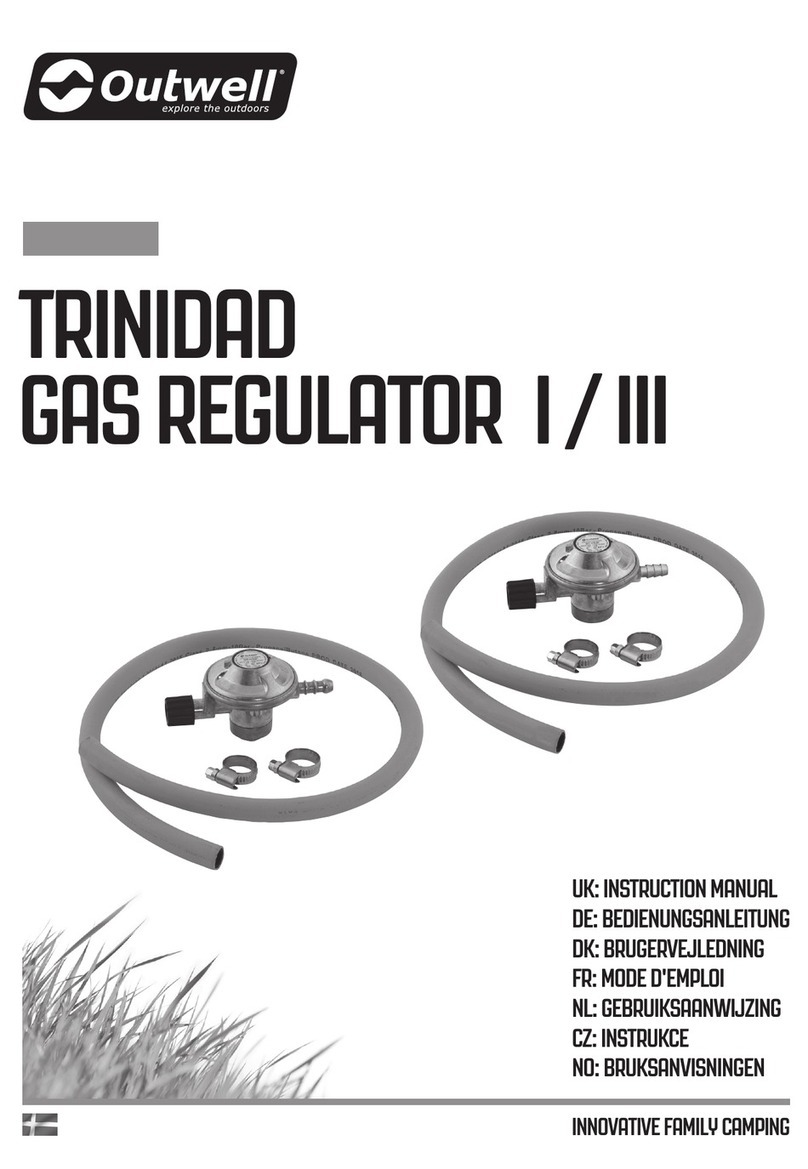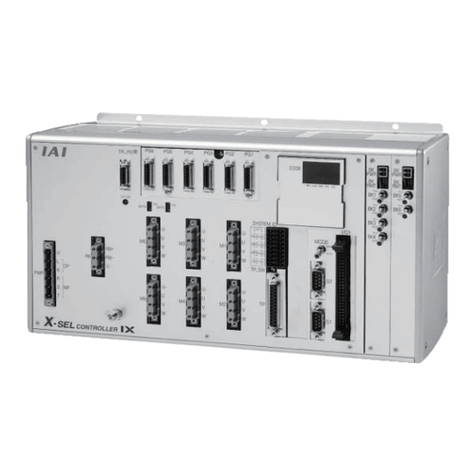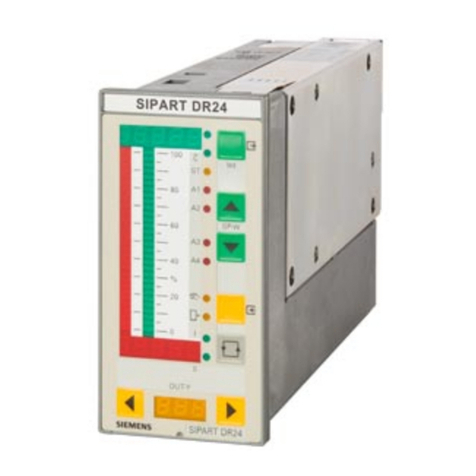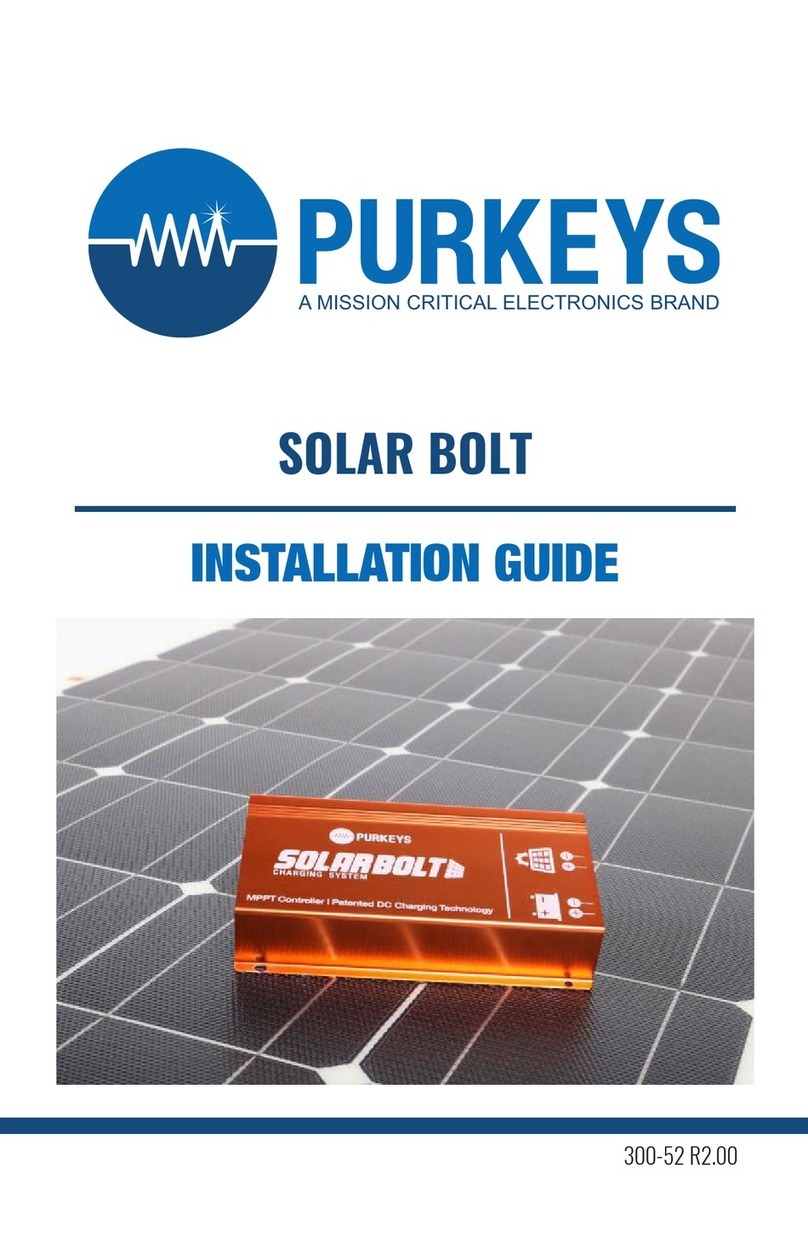Bitzer KT-230-1 Manual

KT-230-1
Compressor control module for ECOLINE reciprocating compressor
Translation of the original document
English....................................................................................................................................................... 2
Verdichtersteuermodul für ECOLINE Hubkolbenverdichter
Originaldokument
Deutsch ..................................................................................................................................................... 16
CM-RC-01
Electrically skilled installer
Elektrisch unterwiesener Monteur

KT-230-12
Table of contents
1 Introduction............................................................................................................................................................3
2 Safety ....................................................................................................................................................................3
2.1 Authorized staff..............................................................................................................................................3
2.2 Residual risks ................................................................................................................................................3
2.3 Safety references...........................................................................................................................................3
2.3.1 General safety references.................................................................................................................. 4
3 Technical data .......................................................................................................................................................4
3.1 Equipment versions .......................................................................................................................................5
3.2 Dimensional drawings....................................................................................................................................6
4 Control and monitoring functions...........................................................................................................................7
4.1 Control functions............................................................................................................................................7
4.2 Monitoring and protective functions ...............................................................................................................7
5 Electrical connection..............................................................................................................................................8
5.1 Schematic wiring diagram for part winding start ............................................................................................8
5.2 Schematic wiring diagram for star-delta start ................................................................................................8
5.3 Legend for the schematic wiring diagrams ....................................................................................................8
5.4 Motor start function ......................................................................................................................................11
5.5 Wiring in the state of delivery.......................................................................................................................11
5.6 High pressure switch ...................................................................................................................................11
6 Connecting cables ...............................................................................................................................................11
6.1 Required electrical connections on the CM-RC-01......................................................................................12
6.2 Optional electrical connections ....................................................................................................................12
6.3 Controlling the CRII using the system controller..........................................................................................13
6.3.1 Control via analogue signal.............................................................................................................. 13
6.3.2 Control via Modbus interface ........................................................................................................... 13
6.4 Connecting the operation monitoring device with the BEST Software ........................................................13
7 Protective functions .............................................................................................................................................13
8 Monitor the operating parameters using the BEST Software ..............................................................................14
8.1 Communication via the BEST Software.......................................................................................................14
8.2 Configuring CM-RC-01 with the BEST Software .........................................................................................15
8.2.1 Setting the current time.................................................................................................................... 15
8.2.2 Checking the motor start function .................................................................................................... 15
8.2.3 Activating application limits monitoring ............................................................................................ 15
8.3 Data log .......................................................................................................................................................15

KT-230-1 3
1 Introduction
The CM-RC-01 compressor control module integrates
the entire electronic periphery of the compressor:
The CM-RC-01 monitors the essential operating para-
meters of the reciprocating compressor: motor and dis-
charge gas temperature, oil supply and application lim-
its. It protects the compressor from operation under crit-
ical conditions. The module provides virtually stepless
control of the compressor depending on the capacity
requirements of a superior system controller. It controls
the capacity regulators, the compressor cooling, the oil
heater and, if necessary, the start unloading and
provides the voltage supply of the associated compon-
ents. Moreover, it controls the activation and deactiva-
tion of the motor contactors during the start. Additional
time relays are not required.
For delivery, the compressor control module can op-
tionally be pre-installed on the reciprocating com-
pressors 4VES-6Y to 8FE-70(Y). For this, several
equipment versions are possible.
During the operation, numerous operating data of the
compressor can be tracked using the BEST Software,
for example, the position in the application limits dia-
gram. These data are recorded and allow the system
operation to be diagnosed. 4 coloured LEDs indicate
the operating condition of the compressor control mod-
ule.
This Technical Information describes the control and
monitoring functions, the electrical connection of the
compressor control module and the communication
with the BEST Software.
2 Safety
Compressors and compressor control module have
been built in accordance with state-of-the-art methods
and current regulations. Particular importance was
placed on user safety.
The notes given in the Operating Instructions KB-104
must be followed in addition to this Technical Informa-
tion.
Always keep the Operating Instructions KB-104 and
this Technical Information in the vicinity of the refrigera-
tion system during the whole lifetime of the com-
pressor!
Also observe the following technical documents
Number Topic
KT-101 CRII: Capacity control
KT-110 Start unloading
KT-130 CIC system
KT-140 Additional cooling
KT-150 Oil heater
KT-170 Oil pressure monitoring
DT-300 OLC-D1: opto-electronic oil level monit-
oring
KG-230 Programming and control
2.1 Authorized staff
All work done on the compressors, the refrigeration
systems and their electronic accessories may only be
performed by qualified and authorized personnel who
have been trained and instructed accordingly. The local
regulations and guidelines will apply with respect to the
qualification and expertise of the specialists.
2.2 Residual risks
Compressors and electronic accessories may present
unavoidable residual risks. This is why any person
working on this device must carefully read this docu-
ment!
The following regulations shall apply:
• the relevant safety regulations and standards (e.g.
EN378, EN60204 and EN60335),
• generally accepted safety rules,
• EU directives,
• national regulations.
2.3 Safety references
are instructions intended to prevent hazards. Safety ref-
erences must be stringently observed!
!
!
NOTICE
Instructions on preventing possible damage to
equipment.
CAUTION
Instructions on preventing a possible minor haz-
ard to persons.
WARNING
Instructions on preventing a possible severe
hazard to persons.

KT-230-14
DANGER
Instructions on preventing an immediate risk of
severe hazard to persons.
2.3.1 General safety references
To be observed when performing work on the
compressor
WARNING
The compressor is under pressure!
Serious injuries are possible.
Depressurize the compressor!
Wear safety goggles!
When working on the electrical and/or electronic
system, please observe the following
WARNING
Risk of electric shock!
Before working on the terminal box, module
housing and electrical lines: Switch off the main
switch and secure it against being switched on
again!
Close the terminal box and the module housing
before switching on again!
!
!
NOTICE
The compressor control module may be dam-
aged or fail!
Never apply any voltage to the terminals of CN7
to CN12 – not even for test purposes!
The voltage applied to the terminals of CN13
must not exceed 10V!
The voltage applied to terminal 3 of CN14 must
not exceed 24V! Do no apply voltage to the
other terminals!
3 Technical data
Compressor control module
Operating voltage 115..230V +10%/-15%, 50/60Hz, max. 600VA
Required fuse 4A time-lag at 230V / 8Atime-lag at 115V
Inputs, outputs and peripheral devices
Relay outputs for motor con-
tactors
Terminal strip CN2
Maximum continuous current 2.5A
Switching voltage 250VAC
Maximum switching current 2.5A
Switching capacity 300VA inductive (NC contact: D300, NO contact:C300)
Voltage outputs for peripheral
devices
Terminal strip CN3: High pressure switch, CN4: Oil heater, CN5: Additional
fan, CN6: Solenoid valves
115..230V +10%/-15%, 50/60Hz, according to the selected operating
voltage of the CM-RC-01. Select the peripheral devices accordingly!
Optional temperature sensor
(R11)
Terminal strip CN11
The connection is suitable for a PT1000 sensor with a measuring range
between -40°C..100°C
Analogue signal used for capa-
city control
Terminal strip CN13
0..10VDC, ±2% at 100%
at max. 1mA
Modbus connection Terminal strip CN14
Modbus RTU, RS485
Connection cable
Connection cable for power
connections
Terminal strips CN1 to CN6
The terminals are suitable for max. 2.5mm2 (AWG12)

KT-230-1 5
Select the cable cross-sections in accordance with the local regulations!
Use copper cables with a sheath quality suitable for at least 85°C. Select the
cable quality according to the installation location, e.g. UV- and/or oil-resist-
ant.
Connection cable for control
and sensor signals
Terminal strips CN7 to CN14
The terminals are suitable for max. 1.5mm2 (AWG16)
Select the cable cross-sections in accordance with the local regulations!
Use copper cables with a sheath quality suitable for at least 85°C. Select the
cable quality according to the installation location, e.g. UV- and/or oil-resist-
ant.
Available cable bushings in the
module housing
For standard version: 2 x M25, 2 x M20, 1 x M16, each with screwed joints
For equipment versions A and B: 1 x M25, 2 x M20, 1 x M16, each with
screwed joints
Characteristics of the compressor control module
Enclosure class Module housing in its state of delivery:
IP65 for 4VES-6Y..6FE-50(Y), IP54 for 8GE-50(Y)..8FE-70(Y)
Control module without module housing: IP00
Internal fuse Terminal strips CN4 to CN6
This overcurrent fuse protects the CM-RC-01, if a short circuit occurs in one of
the connected components: oil heater, additional fan or in a solenoid valve.
A warning is output in the BEST Software or via Modbus.
Place of installation Allowable ambient temperature: -30°C..+70°C
Allowable relative humidity: 5%..95% (EN60721-3-3 Classes 3K3 and 3C3)
Maximum allowable altitude: 2000m
EMC The control module complies with the EMC directives 2014/30/EU and
2004/108/EC
Interference immunity
EN61000-6-1:2007, Immunity for residential, commercial and light-industrial
environments
EN61000-6-2:2005, Immunity for industrial environments
Emitted interference
EN61000-6-3:2007 +A1:2011, Emission standard for residential, commercial
and light-industrial environments.
The control module internally supplies the voltage to
peripheral devices (solenoid valves, additional fan, oil
monitoring and oil heater) and to the terminal strips
CN7 to CN12.
3.1 Equipment versions
For delivery, the compressor control module can op-
tionally be pre-installed in the reciprocating com-
pressors 4VES-6Y to 8FE-70(Y). Several versions and
extensions are possible.
Standard state of delivery
In the table, the standard state of delivery is marked as
"standard". These components are completely mounted
and electrically connected.

KT-230-16
Equipment versions A and B
These equipment versions are provided, in addition to
the standard state of delivery, with further components
which are completely mounted and electrically connec-
ted. In the table, these functions are marked with "A" or
"B".
Extensions
The components which can be retrofitted are marked in
the table as "options". They are delivered as accessor-
ies kit and must be mounted, wired and activated via
the BEST Software.
4VES-6Y..4N
ES-20(Y)
4JE-13Y..4FE
-35(Y)
6JE-22Y..6FE
-50(Y)
8GE-50(Y)..8
FE-70(Y)
Motor temperature monitoring (R1..R6) Standard Standard Standard Standard
Discharge gas temperature sensor (R7) Standard Standard Standard Standard
Oil monitoring (F4) Standard:
OLC-D1: opto-
electronic oil
level monitor-
ing
Standard:
DP-1: differen-
tial oil pressure
monitoring
Standard:
DP-1: differen-
tial oil pressure
monitoring
Standard:
DP-1: differen-
tial oil pressure
monitoring
2 capacity regulators (Y3-1 and Y3-2) A: CRII-1 and
CRII-2
A: CRII-1 and
CRII-2
A: CRII-1 and
CRII-2
A: CRII-1 and
CRII-2
Start unloading (Y1) B: SU B: SU B: SU
Capacity regulator (Y3-2) B: CRII-2 B: CRII-2 B: CRII-2
3rd capacity regulator (Y3-3) Option: CRII-3
Monitoring of application limits: High pres-
sure transmitter (B6) and low pressure
transmitter (B7)
Option Option Option Option
Additional fan (M2) Option Option Option
CIC additional cooling (Y5) Option Option Option
Optional temperature sensor (R11) Option Option Option Option
Tab.1: CM-RC-01: pre-assembled variants and possible extensions
Information
Upon market launch, not all components are
available for each connection voltage. This is
also valid for the CIC system and the equipment
version B. The CM-RC-01, however, is able to
control the start unloading. Information regard-
ing retrofitting available upon request.
3.2 Dimensional drawings
These dimensional drawings show the equipment ver-
sions "A" and "B". The pre-assembled options and pos-
sible extensions differ depending on the compressor
series, see chapter Equipment versions, page 5.
CM-RC-01 in 4VES-6Y .. 4NES-20(Y)
430
63
382
63
716
162 187
A
B
C
D
CRII-2 1 2 CRII-1/SU
Option Option
3OLC-D14
Fig.1: 4VES-6Y .. 4NES-20(Y) with CM-RC-01
Connection positions
1 Discharge gas temperature sensor
2 Connection position for high pressure
switch
3 Cable holder
4 Oil heater
A Cover for terminal box
B Module housing (grey)

KT-230-1 7
Connection positions
D LED sight glass
D Terminal box
Dimensional drawings for 4JE-13Y..8FE-70(Y) upon
request.
Upon market launch, a high pressure switch with a cut-
out pressure of 32bar is mounted at position 2 and
electrically connected to the CM-RC-01. For the com-
pressors 4VES-6Y to 4NES-20(Y), a high pressure lim-
iter is used. For all other compressors, a high pressure
cut-out is used.
4 Control and monitoring functions
4.1 Control functions
This chapter describes all control functions including
the options.
Capacity control CRII
The CM-RC-01 provides virtually stepless adjustment
of the compressor capacity depending on the setpoint
of the superior system controller. This is done by
switching the CRII solenoid valves. 4-cylinder com-
pressors with 2 and 6-cylinder compressors with 3 in-
stalled capacity regulators are regulated between full
load and 10% part load, 8-cylinder compressors
between full load and 50%.
If a start unloading is mounted, there is one cylinder
bank less available for the capacity control. The range
of control for the capacity control is reduced accord-
ingly.
Start unloading SU
The start unloading can be installed for 4 and 6-cylinder
compressors. The module controls the solenoid valve
and ensures an unloaded compressor start.
Compressor cooling
The compressor control module activates the additional
fan when the discharge gas temperature of 120°C is
exceeded and deactivates it as soon as a temperature
of 100°C is reached. If the discharge gas temperature
reaches 135°C, the CIC is activated intermittently, from
a temperature of 140°C, it works permanently. While
the CIC is active, the compressor can only be operated
in the upper part-load range. The limit is 50% for 4-cyl-
inder compressors and 66% for 6-cylinder com-
pressors.
The module activates the additional fan in the lower
part-load range to cool down the motor, if necessary.
This is done for 4-cylinder compressors in a part-load
range below 50% and for 6-cylinder compressors below
33%.
Oil heater
When the compressor is at standstill, the module
switches the oil heater on and if the compressor is in
operation, the oil heater is switched off.
Control of the motor contactors at compressor start
The compressor control module controls the activation
and deactivation times of the motor contactors. In the
state of delivery, the time relay control is configured for
the installed motor:
Part winding motor: The contact at CN2:2 (K1 Control)
closes 1second after the release signal. The contact at
CN2:1 (K2 Control) closes 0.5seconds afterwards.
Both contacts remain closed until the compressor is
shut off.
Star-delta motor: The contact at terminal CN2:2 (K1
Control) closes 1second after the release signal and
reopens after further 1.5seconds. The contact at ter-
minal CN2:1 (K2 Control) closes 1.5seconds after the
release signal and remains closed until the compressor
is shut off.
Motor for direct-on-line start: The contact at terminal
CN2:2 (K1 Control) closes 1second after the release
signal and reopens when the compressor is shut off.
The contact at terminal CN2:1 (K2 Control) is not used.
For a soft start and operation with frequency inverter,
only one motor contactor is required.
4.2 Monitoring and protective functions
The compressor control module monitors the signals
from several sensors that may be located on the com-
pressor or on the suction gas and discharge gas line:
Monitored function Measuring sensor
Motor temperature
(standard)
Motor temperature sensor
(R1..R6)
Discharge gas temper-
ature (standard)
Discharge gas temperature
sensor (R7)
Application limits (op-
tion):
Condensing and evap-
oration temperature
Low pressure and high
pressure transmitters (B7
and B6)
Low pressure (option) Low pressure transmitter
(B7)

KT-230-18
Monitored function Measuring sensor
High pressure (option) High pressure transmitter
(B6)
Oil supply (standard) Oil level monitoring with
OLC-D1 (F4) on 4VES-6Y
to 4NES-20(Y)
Differential oil pressure
monitoring with DP-1 (F4)
on 4JE-13Y to 8FE-70(Y)
Cycling rate of the
compressor (standard)
Integrated in CM-RC-01
Temperature at any
place (option)
Optional temperature
sensor
The compressor control module compares the meas-
ured values with the the programmed data, sending
signals via Modbus and indicating the operating condi-
tion by means of differently coloured LEDs, see chapter
Protective functions, page 13. The compressor will be
shut off in case of operation beyond the application lim-
its, lack of oil or excessive motor temperature. The cyc-
ling rate and the measured value of the optional tem-
perature sensor are monitored and recorded.
5 Electrical connection
Keep the compressor control module energized when
the motor is not running. If necessary, the module activ-
ates the oil heater, thus ensuring the lubricity of the oil
even after a long standstill period.
De-energize the module only if you plan a long stand-
still period of the compressor or for maintenance pur-
poses.
5.1 Schematic wiring diagram for part winding start
Schematic wiring diagram, see figure 2, page 9. In
the event of direct start, path 4 is omitted: contactor K2
and thermal overload relay F14 as well as the cable
connection on the terminal strip CN2, terminal 1. For
soft start and operation with frequency inverter, only
one contactor is required.
For operation with frequency inverter, please observe
the following: Emit the release signal to the compressor
control module only after charging of the DC link during
the first switch-on.
5.2 Schematic wiring diagram for star-delta start
In the event of star-delta start, the motor contactors are
not connected according to the terminal labelling on the
CM-RC-01, see figure 3, page 10.
5.3 Legend for the schematic wiring diagrams
Abbr. Component
B1 Command for compressor start (release sig-
nal from system controller)
B6 High pressure transmitter
B7 Low pressure transmitter
F1 Main fuse
F2 Compressor fuse
F3 Control circuit fuse
F4 Oil monitoring: 4VES-6Y..4NES-20(Y): OLC-
D1 / 4JE-13Y..8FE-80(Y): DP-1
F5 High pressure switch
F13 Thermal overload relay "Motor" (1st part wind-
ing and Y/Δ)
F14 Thermal overload relay "Motor" (2nd part
winding)
F17 Control transformer fuse
H3 Signal lamp "Collective fault"
K1 Contactor "1st part winding" (PW) or main
contactor (Y/Δ)
K2 Contactor "2nd part winding" (PW) or delta
contactor (Y/Δ)
K3 Star contactor (Y/Δ)
M1 Compressor
M2 Additional fan
Q1 Main switch
R1..
6
PTC sensor in motor winding
R7 Discharge gas temperature sensor
R8 Oil heater
R11 Optional temperature sensor (not included in
the scope of delivery)
S1 Control switch (on/off)
S2 Fault reset of CM-RC-01
T1 Control transformer (example for 230V)
Y1 Solenoid valve "Start unloading SU"
Y3-1 Solenoid valve "1st capacity regulator CRII"
Y3-2 Solenoid valve "2nd capacity regulator CRII"
Y3-3 Solenoid valve "3rd capacity regulator
CRII" (only for BE6 compressors)
Y5 CIC injection valve
Tab.2: Components of the schematic wiring diagrams

KT-230-1 9
1 2 3 4
CN1
L N
CN2
K2control
Supply
Supply
K1control
RelayC
RelayNC
CN3
HPS
HPS
CN4
Heater
Heater
CN5
Add. fan
Add. fan
CN6
CR-1
CR-1
CR-2
CR-2
CR-3
CR-3
Injection
Injection
5 6 7 8
CN7
1 2 3 4 1 2
CN9
CN10
1 2 3 4 5 6
CN12
1 2 3 4
CN11
1 2
CN13
1 2 3 4
CN14
24VSup
GND
Signal
GND
PTC
PTC
Signal
GND
Signal
GND
5VSup
Signal
GND
5VSup
Signal
GND
Input
GND
Data+
Data–
Sup In
GND
24VSup
GND
Signal
GND
21 3 4 1 2 1 N 1 N 1 N 3 N 5 N 7 N
CM-RC-01
4321 876
513
1211
109 14 15 16 17 18 19 20 21 22
S2
F2
L1
L2
L3
PE F1
Q1
1
0
K1
11 K2
10
M 3~
F13
8
F17
230V
T1
F3 4A T
PE
S1
01
F13
2
B1
H3
W1
V1
U1
V2
U2
W2
M1
K2
Y3-2
Y5
4/4/4
grau/grey
braun/brown
orangerosa
pink
blau/blue
B6
B7
Modbus
RS485
PE
0 .. 10V
R7
PE
F5
P> R8
M2
Y3-1
1 2
CT
CT
CN8
R11
1
3
2
1
3
2
R1..6
F14
4
F14
8
2/2/2
K1
(2CP5-71-49)
(2CP5-71-47)
F4
F4
OLC-D1
DP-1
CN9:3
CN9:4
Y3-3
M
1~
Fig.2: Schematic wiring diagram for part winding start

KT-230-110
1 2 3 4
CN1
L N
CN2
K2control
Supply
Supply
K1control
RelayC
RelayNC
CN3
HPS
HPS
CN4
Heater
Heater
CN5
Add. fan
Add. fan
CN6
CR-1
CR-1
CR-2
CR-2
CR-3
CR-3
Injection
Injection
5 6 7 8
CN7
1 2 3 4 1 2
CN9
CN10
1 2 3 4 5 6
CN12
1 2 3 4
CN11
1 2
CN13
1 2 3 4
CN14
24VSup
GND
Signal
GND
PTC
PTC
Signal
GND
Signal
GND
5VSup
Signal
GND
5VSup
Signal
GND
Input
GND
Data+
Data–
Sup In
GND
24VSup
GND
Signal
GND
21 3 4 1 2 1 N 1 N 1 N 3 N 5 N 7 N
CM-RC-01
4321 876
513
1211
109 14 15 16 17 18 19 20 21 22
S2
F2
L1
L2
L3
PE F1
Q1
1
0
K1
10 K2
11
M 3~
F13
8
K3
12
F17
F3 4A T
PE
S1
01
F13
2
B1
H3
W1
V1
U1
V2
U2
W2
M1
2/2/2
K1 K2
K3
12
Y3-2
Y5
4/4/4
grau/grey
braun/brown
orangerosa
pink
blau/blue F4
B6
B7
Modbus
RS485
PE
0 .. 10V
5/5/5
K3
11
R7
PE
R8
M2
Y3-1
1 2
CT
CT
CN8
R11
1
3
2
1
3
2
R1..6
F5
P>
F4
Y3-3
(2CP5-71-49)
(2CP5-71-47)
OLC-D1
DP-1
CN9:3
CN9:4
230V
T1
M
1~
Fig.3: Schematic wiring diagrams for star-delta start

KT-230-1 11
5.4 Motor start function
The compressor control module controls the activation
and deactivation times of the motor contactors. In the
state of delivery, the time relay control is configured for
the installed motor.
5.5 Wiring in the state of delivery
The following components are pre-installed and wired
in the state of delivery:
• Oil heater (standard, R8)
• Oil monitoring (standard, F4)
• Discharge gas temperature sensor (standard, R7)
• additionally for equipment version A: 2 solenoid
valves for capacity control (Y3-1 and Y3-2)
• additionally for equipment version B: 1 solenoid
valve for start unloading (Y1) and 1 solenoid valve
for capacity control (Y3-2)
• and additionally during the market launch phase:
High pressure switch (standard, F5)
These components are shown in a slightly darker grey
in the schematic wiring diagram. Modification to these
components or their wiring is not required and should
not be done without consulting BITZER.
All other optional components are shown in light grey.
They are delivered as accessories kit and must be
mounted and wired.
5.6 High pressure switch
According to the EN 378, each compressor must be
provided with a high pressure switch (F5) for safety cut-
out in the safety chain. This switch can be mounted dir-
ectly to the compressor and integrated into the elec-
trical safety chain via the CM-RC-01. Mounting position
see chapter Dimensional drawings, page 6, connect the
cables directly to the terminal strip CN3 according to
the schematic wiring diagram.
If optional application limits monitoring is installed, the
installation of a low pressure switch is not necessary
because the automatic low pressure cut-out function of
the compressor control module is active.
6 Connecting cables
Electrically connect the compressor control module in
accordance with the schematic wiring diagram. Ob-
serve the safety standards EN60204, EN60364 and
national safety regulations.
WARNING
Risk of electric shock!
Before working on the terminal box, module
housing and electrical lines: Switch off the main
switch and secure it against being switched on
again!
Close the terminal box and the module housing
before switching on again!
!
!
NOTICE
The compressor control module may be dam-
aged or fail!
Never apply any voltage to the terminals of CN7
to CN12 – not even for test purposes!
The voltage applied to the terminals of CN13
must not exceed 10V!
The voltage applied to terminal 3 of CN14 must
not exceed 24V! Do no apply voltage to the
other terminals!
The CM-RC-01 is installed directly above the terminal
box for the power connection of the compressor. For
the 8-cylinder compressors, it is located in the terminal
box.
Compressor power connection
• Remove the module housing cover.
• The module housings of the 4-cylinder and 6-cylin-
der compressors are screwed to the terminal box for
the power connection of the compressor. Remove
the module housing. Make sure that the two orange
cables and the protective earth conductor are not
damaged and that the connections do not become
detached. The orange cables are the motor temper-
ature sensor cables.
• Connect the power connection cable for the com-
pressor motor according to the label on the lower
part of the module housing and the Operating In-
structions KB-104. The label for 8-cylinder com-
pressors is located on the inside of the terminal box
cover.
• Both orange cables and protective earth conductor:
Check the cables. Check the cable connections on
the terminal plate for tight seat.
• Re-attach the module housing on 4-cylinder and 6-
cylinder compressors.

KT-230-112
6.1 Required electrical connections on the CM-RC-01
• Module power connection on terminal strip CN1
(115 .. 230V +10%/-15%, 50/60Hz)
– Terminal 1: L
– Terminal 2: N
• Command for compressor start (release signal from
the system controller, B1)
The release signal from the system controller is
provided in path 8 as the first link of the safety chain.
This release information must be passed on to the
compressor control module. It activates the time re-
lay control for the motor contactors K1, K2 and K3.
– Connect the safety chain (release signal) to ter-
minal strip CN2, terminal 3.
– Integrate the compressor control module as the
last link into the safety chain.
– Connect the contactors directly to terminal strip
CN2 according to the schematic wiring diagram.
• Control signal from the system controller (setpoint for
capacity control, CRII)
This connection is only required if the compressor is
equipped with capacity regulators.
– Connect the Modbus cable to terminal strip CN14.
– Or connect the analogue signal to terminal strip
CN13.
• Close the module housing:
– Check if the cable connections of the protective
earth conductors are tight.
– Re-attach the module housing cover and screw it
down.
6.2 Optional electrical connections
Monitoring of application limits
High pressure and low pressure transmitters B6 and B7
are delivered as accessories kit if the "Application limits
monitoring" option has been ordered. They must be
mounted to the system, wired with the CM-RC-01 and
activated via the BEST Software. The two transmitters
must not be interchanged. They differ by the compon-
ent number engraved in the component:
• High pressure transmitter B6: 2CP5-71-47
• Low pressure transmitter B7: 2CP5-71-49
Mounting position: Connect them to the discharge gas
line and/or the suction gas line, as close as possible to
the valves using a refrigerant hose for each valve.
Length of the refrigerant hose: at least 200mm to avoid
dew formation on the transmitter.
Electrical connection: Connect the cables at the CM-
RC-01 directly to terminal strip CN12 according to the
schematic wiring diagram.
Additional fan
Mount the fan feet to the cylinder heads. Please refer to
the Technical Information KT-140.
Connect the cable of the additional fan to the CM-
RC-01 to terminal strip CN5 according to the schematic
wiring diagram.
CIC system
WARNING
The compressor is under pressure!
Serious injuries are possible.
Depressurize the compressor!
Wear safety goggles!
Mounting: Connect the injection nozzle to the CIC con-
nection. This position is described in the Operating In-
structions of the compressor KB-104 (dimensional
drawings: connection position 4). With 6-cylinder com-
pressors, 2 nozzles are mounted.
• Remove the plug from the compressor.
• Clean and check the threaded bore.
• Mount the gasket and the injection nozzle according
to KT-130, chapter 5.4 "Injection nozzle and injection
valve".
• Press the solenoid coil onto the armature. It locks.
• Insert the electric connector of the device and screw
it down (5Nm).
• Connect the cables of the CM-RC-01 to terminal
strip CN6, terminals 7 and 8, according to the
schematic wiring diagram.
Third capacity regulator Y3-3
For 6-cylinder compressors, a third capacity regulator
can be activated. The CRII cylinder head required for
this is mounted in the state of delivery if the com-
pressor has been ordered accordingly. It can also be
retrofitted. Further information on the mounting of the
solenoid valve and the CRII cylinder head can be found
in the Technical Information KT-101.
Electrical connection: Connect the cables of the CM-
RC-01 to terminal strip CN6, terminals 5 and 6, accord-
ing to the schematic wiring diagram.

KT-230-1 13
Optional temperature sensor R11
An optional PT1000 temperature sensor can be con-
nected to the control. The data of the temperature
sensor are logged but they do not influence the control
and the monitoring.
Electrical connection: Connect the cables of the CM-
RC-01 to terminal strip CN11, terminals 1 and 2, ac-
cording to the schematic wiring diagram.
The BEST Software detects this sensor automatically.
6.3 Controlling the CRII using the system controller
CRII can be controlled via Modbus or an analogue sig-
nal. Compressor operation at reduced capacity is only
admissible within the part-load limits for the respective
refrigerant. Minimum residual capacity: 10%. Program
the system controller accordingly. Application limits,
see BITZER Software and Technical Information
KT-101.
6.3.1 Control via analogue signal
The compressor capacity is regulated via a DC voltage
signal. This type of control is mainly suitable for sys-
tems with simple controllers which are equipped with
an output for 0 to 10V and a relay, and for use in com-
bination with the BEST Software on Modbus connec-
tion.
• Connection to terminal strip CN13, terminals 1 and
2.
• Control signal: 0 to 10V direct current voltage for an
analogue output of the system controller
• Control accuracy: ±0.5% at 100%
• Linear control characteristic, see figure.
CRII
0 2 4 6 8 10 12
U [V]
0 .. 10 V
100%
CRmin
CRmin
1
80%
60%
40%
20%
0%
0,2
*
Fig.4: Control characteristic
• CRmin: The compressor capacity can be reduced
from 100% to 10% if each cylinder head is equipped
with CRII capacity regulators.
• CRmin* and dashed line: The range of control is re-
duced if not every cylinder bank is equipped with ca-
pacity regulators. The minimum capacity step of 50%
is the lower regulation limit for 8-cylinder com-
pressors and for 4-cylinder compressors with one
capacity regulator. In this case, the CM-RC-01 regu-
lates to a residual capacity of 50% as soon as the
control signal falls below 5V.
6.3.2 Control via Modbus interface
Insert or connect the cable to terminal strip CN14. See
schematic wiring diagrams.
In this case, the operating parameters can be mon-
itored via Bluetooth by means of the BEST Software.
6.4 Connecting the operation monitoring device with
the BEST Software
• Connect the BEST interface converter to terminal
strip CN14 (Modbus).
In this case, the capacity control must be predefined via
the analogue signal on terminal strip CN13.
The BEST Software can access the compressor control
module via a Bluetooth interface, see chapter Commu-
nication via the BEST Software, page 14. This inter-
face is not available upon market launch.
7 Protective functions
The green LED is on during normal operation. The
LEDs can be seen through a sight glass in the module
housing, see chapter Dimensional drawings, page 6.
Before the measured value of a sensor reaches a crit-
ical threshold, the compressor control module outputs a
warning signal via the Modbus RS485 interface
(CN14). In this case, the yellow LED lights up. Once a
measured value is considerably outside the allowable
range, the compressor control module will immediately
switch off the motor. The red LED lights up.
The blue LED lights up when data are transmitted via
the Modbus interface.
Depending on the measured parameter, up to 3 alarm
levels are defined. These alarms are recorded and dis-
played using the BEST Software. The alarm levels
make it possible to programme a system controller in a
way that allows the compressor to be adjusted within
the application limits.

KT-230-114
Warning
The warning threshold is exceeded when the applica-
tion limit is almost reached. The yellow LED lights up.
This is a software message, not a safety reference. The
warning refers exclusively to the critical operating con-
dition of the compressor.
Critical alarm
The cut-out value is exceeded. The yellow LED lights
up. If the corresponding measured value does not drop
again within 30 seconds, the compressor will be
switched off. This cut-out is classified as fault in the
alarm list.
Fault
The cut-out value has been exceeded too much or for
too long. The compressor is switched off. The red LED
lights up.
Monitored function Time delay after
compressor start
Warning Critical alarm Fault
Discharge gas temperature --- >135°C --- >150°C
locks out after
20s
Oil supply 90s 5s --- locks out after
90s
Cycling rate of the com-
pressor
--- > 8 compressor
cut-outs within one
hour
--- ---
Application limits, option
(Condensing temperature,
evaporation temperature)
120s <2K within the
application limits
>2K outside the
application limits
locks out after
30s
>4K outside the
application limits
locks out immedi-
ately
Low pressure, option --- --- --- <0.2bar / < relat-
ive pressure
entered in BEST
Software: locks
out immediately
High pressure, option --- --- --- >32 bar / >relat-
ive pressure
entered in BEST
Software:
locks out immedi-
ately
Reset
Disconnect the voltage supply (L/N) for at least 5
seconds, via Modbus command or reset alarms with
the BEST Software by pressing the RESET button in the
ALARMS menu.
8 Monitor the operating parameters using the BEST
Software
The BEST Software displays all active alarms and the
following operating parameters:
• Capacity control level
• Condensing temperature
• Evaporation temperature
• Low pressure
• High pressure
• Discharge gas temperature
8.1 Communication via the BEST Software
Requirements:
• Mobile device
– equipped with the operating system Windows XP
or newer

KT-230-1 15
– with USB port or Bluetooth
– with BEST Software installed
The BEST Software can be downloaded for free
from the BITZER website (www.bitzer.de).
• Data connection
– via BEST interface converter
– or via Bluetooth 4.0. Range approx. 3m
• If the BEST interface converter is used, the com-
pressor must be controlled via the analogue connec-
tion (CN13). The Modbus connection does not allow
capacity control and BEST data connection at the
same time. Bluetooth is not available upon market
launch.
Setting up communication
• Only for communication via the BEST interface con-
verter: Plug the cable into the compressor control
module (CN14) and the mobile device.
• Switch on the mobile device and start the BEST
Software.
A window displaying the available devices opens.
• Select CM-RC-01.
• Click the CONNECT button.
• Only for communication via Bluetooth: Enter the au-
thorization code.
The CONFIGURATION menu appears with the MAIN SETUP
window. This concludes the connection of the com-
pressor control module to the mobile device.
8.2 Configuring CM-RC-01 with the BEST Software
In its state of delivery, the compressor control module
CM-RC-01 is configured for the compressor, in which it
is built in, and its motor. Date and time should be
checked and adjusted if necessary. Afterwards, a con-
figuration of the installed options is required. Depend-
ing on the system design, it may be useful to adjust
some other parameters.
8.2.1 Setting the current time
Check the programmed date and time using the BEST
Software:
• Check the CONFIGURATION menu, the MAIN SETUP win-
dow and the DATE and TIME lines.
• Correct the data if necessary.
8.2.2 Checking the motor start function
The compressor control module controls the activation
and deactivation times of the motor contactors. In the
state of delivery, the time relay control is configured for
the installed motor. The BEST Software can be used to
check and change the configured motor start method
(part winding, star-delta or direct-on-line start).
Check in the BEST Software and adapt if necessary:
• CONFIGURATION menu, MOTOR STARTER FUNCTION win-
dow. When operating with frequency inverter or soft
starter, the system must be set to direct-on-line start.
If necessary, set the suitable motor start function.
In any case, the compressor motor is activated
1second after the release signal of the superior system
controller.
8.2.3 Activating application limits monitoring
◦ Requirements: High pressure and low pressure
transmitters are installed.
• Set the refrigerant in the BEST Software: select the
refrigerant used in the REFRIGERANT window in the
MAIN SETUP menu.
• Enter relative pressure limit values that are adapted
to the system in the CONFIGURATION menu, PROTECTIVE
FUNCTIONS window, in the lines HIGH PRESSURE SWITCH:
VALUE and LOW PRESSURE SWITCH: VALUE. Basic set-
ting: 32bar / 0.2bar, relative pressures. The high
pressure cannot be further increased.
8.3 Data log
All monitored operating parameters and alarm mes-
sages are stored internally:
• All operating parameters in 10-second intervals of at
least the last 14 days
• The last 10 faults in detail
• Statistics for the last 365 days
The data can be exported as files using the BEST Soft-
ware. They enable an analysis of the system operation
and detailed error diagnostics if necessary.

KT-230-116
Inhaltsverzeichnis
1 Einleitung.............................................................................................................................................................17
2 Sicherheit.............................................................................................................................................................17
2.1 Autoriertes Fachpersonal.............................................................................................................................17
2.2 Restgefahren ...............................................................................................................................................17
2.3 Sicherheitshinweise.....................................................................................................................................17
2.3.1 Allgemeine Sicherheitshinweise ...................................................................................................... 18
3 Technische Daten................................................................................................................................................18
3.1 Ausstattungsvarianten .................................................................................................................................19
3.2 Maßzeichnungen .........................................................................................................................................20
4 Steuer- und Überwachungsfunktionen ................................................................................................................21
4.1 Steuerfunktionen..........................................................................................................................................21
4.2 Überwachungs- und Schutzfunktionen ........................................................................................................21
5 Elektrischer Anschluss ........................................................................................................................................22
5.1 Prinzipschaltbild für Teilwicklungsanlauf .....................................................................................................22
5.2 Prinzipschaltbild für Stern-Dreieck-Anlauf ...................................................................................................22
5.3 Legende zu den Prinzipschaltbildern...........................................................................................................22
5.4 Motoranlauffunktion .....................................................................................................................................24
5.5 Verkabelung im Auslieferungszustand ........................................................................................................25
5.6 Hochdruckschalter.......................................................................................................................................25
6 Kabel anschließen ...............................................................................................................................................25
6.1 Erforderliche elektrische Anschlüsse am CM-RC-01...................................................................................26
6.2 Optionale elektrische Anschlüsse................................................................................................................26
6.3 CRII mit Anlagenregler steuern ...................................................................................................................27
6.3.1 Steuerung über Analogsignal........................................................................................................... 27
6.3.2 Steuerung über Modbus-Schnittstelle.............................................................................................. 27
6.4 Betriebsüberwachung mit der BEST Software anschließen ........................................................................27
7 Schutzfunktionen .................................................................................................................................................28
8 Betriebsparameter mit der BEST Software überwachen.....................................................................................30
8.1 Kommunikation über die BEST Software ....................................................................................................30
8.2 CM-RC-01 mit der BEST Software konfigurieren ........................................................................................30
8.2.1 Aktuelle Uhrzeit einstellen................................................................................................................ 30
8.2.2 Motoranlauffunktion prüfen .............................................................................................................. 30
8.2.3 Einsatzgrenzüberwachung aktivieren .............................................................................................. 30
8.3 Datenaufzeichnung......................................................................................................................................31

KT-230-1 17
1 Einleitung
Das Verdichtersteuermodul CM-RC-01 integriert die
gesamte elektronische Peripherie des Verdichters:
Das CM-RC-01 erlaubt die Überwachung der wesentli-
chen Betriebsparameter des Hubkolbenverdichters:
Motor- und Druckgastemperatur, Ölversorgung und die
Einsatzgrenzen. Es schützt den Verdichter vor Betrieb
bei kritischen Bedingungen. Das Modul regelt den Ver-
dichter quasi-stufenlos entsprechend der Leistungsan-
forderung eines übergeordneten Anlagenreglers. Es
steuert die Leistungsregler, die Verdichterkühlung, die
Ölheizung und ggf. die Anlaufentlastung und liefert die
Spannungsversorgung der zugehörigen Bauteile. Es
steuert außerdem die Zu- und Abschaltung der Motor-
schütze während des Anlaufs. Zusätzliche Zeitrelais
werden nicht benötigt.
Das Verdichtersteuermodul kann als Option in den
Hubkolbenverdichtern 4VES-6Y bis 8FE-70(Y) vorin-
stalliert ausgeliefert werden. Dabei sind mehrere Aus-
stattungsvarianten möglich.
Zahlreiche Betriebsdaten des Verdichters können mit
der BEST Software während des Betriebs verfolgt wer-
den, beispielsweise der Betriebspunkt im Einsatzgrenz-
diagramm. Diese Daten werden aufgezeichnet und er-
lauben eine Diagnose des Anlagenbetriebs. 4 farbige
LEDs signalisieren den Betriebszustand des Ver-
dichtersteuermoduls.
Diese Technische Information beschreibt die Steuer-
und Überwachungsfunktionen, den elektrischen An-
schluss des Verdichtersteuermoduls und die Kommuni-
kation mit der BEST Software.
2 Sicherheit
Verdichter und Verdichtersteuermodul sind nach dem
aktuellen Stand der Technik und entsprechend den gel-
tenden Vorschriften gebaut. Auf die Sicherheit der An-
wender wurde besonderer Wert gelegt.
Zusätzlich zu dieser Technischen Information müssen
die Hinweise in der Betriebsanleitung KB-104 eingehal-
ten werden.
Betriebsanleitung KB-104 und diese Technische Infor-
mation während der gesamten Verdichterlebensdauer
an der Kälteanlage verfügbar halten!
Folgende technischen Dokumente ebenfalls beachten
Nummer Thema
KT-101 CRII: Leistungsregelung
KT-110 Anlaufentlastung
Nummer Thema
KT-130 CIC-System
KT-140 Zusatzkühlung
KT-150 Ölheizung
KT-170 Öldrucküberwachung
DT-300 OLC-D1: opto-elektronische Ölniveau-
überwachung
KG-230 Programmierung und Überwachung
2.1 Autoriertes Fachpersonal
Sämtliche Arbeiten an Verdichtern, Kälteanlagen und
deren elektronischem Zubehör dürfen nur von Fachper-
sonal ausgeführt werden, das in allen Arbeiten ausge-
bildet und unterwiesen wurde. Für die Qualifikation und
Sachkunde des Fachpersonals gelten die jeweils lan-
desüblichen Vorschriften und Richtlinien.
2.2 Restgefahren
Von Verdichtern und elektronischem Zubehör können
unvermeidbare Restgefahren ausgehen. Jede Person,
die an diesem Gerät arbeitet, muss deshalb dieses Do-
kument sorgfältig lesen!
Es gelten zwingend
• die einschlägigen Sicherheitsvorschriften und Nor-
men (z.B. EN 378, EN 60204 und EN 60335),
• die allgemein anerkannten Sicherheitsregeln,
• die EU-Richtlinien,
• nationale Vorschriften.
2.3 Sicherheitshinweise
sind Anweisungen um Gefährdungen zu vermeiden. Si-
cherheitshinweise genauestens einhalten!
!
!
HINWEIS
Anweisungen um eine mögliche Gefährdung
von Geräten zu vermeiden.
VORSICHT
Anweisung um eine mögliche minderschwere
Gefährdung von Personen zu vermeiden.
WARNUNG
Anweisung um eine mögliche schwere Gefähr-
dung von Personen zu vermeiden.
GEFAHR
Anweisung um eine unmittelbare schwere Ge-
fährdung von Personen zu vermeiden.

KT-230-118
2.3.1 Allgemeine Sicherheitshinweise
Bei Arbeiten am Verdichter beachten
WARNUNG
Verdichter steht unter Druck!
Schwere Verletzungen möglich.
Verdichter auf drucklosen Zustand bringen!
Schutzbrille tragen!
Bei Arbeiten an der Elektr(on)ik beachten
WARNUNG
Gefahr von elektrischem Schlag!
Vor Arbeiten im Anschlusskasten, im Modulge-
häuse und an elektrischen Leitungen: Haupt-
schalter ausschalten und gegen Wiederein-
schalten sichern!
Vor Wiedereinschalten Anschlusskasten und
Modulgehäuse schließen!
!
!
HINWEIS
Beschädigung oder Ausfall des Verdichtersteu-
ermoduls möglich!
An die Klemmen von CN7 bis CN12 keine
Spannung anlegen – auch nicht zum Prüfen!
An die Klemmen von CN13 maximal 10V anle-
gen!
An die Klemme 3 von CN14 maximal 24V, an
die anderen Klemmen keine Spannung anlegen!
3 Technische Daten
Verdichtersteuermodul
Betriebsspannung 115 .. 230V +10%/-15%, 50/60Hz, max. 600VA
erforderliche Sicherung 4Aträge bei 230V / 8Aträge bei 115V
Ein- und Ausgänge sowie Peripheriegeräte
Relaisausgänge für Motor-
schütze
Klemmleiste CN2
Dauerstrom max. 2,5A
Schaltspannung 250V∿
Schaltstrom max. 2,5A
Schaltleistung 300VA induktiv (Öffnerkontakt: D300, Schließkontakt:C300)
Spannungsausgänge für Peri-
pheriegeräte
Klemmleisten CN3: Hochdruckschalter, CN4: Ölheizung, CN5: Zusatzventila-
tor, CN6: Magnetventile
115 .. 230V +10%/-15%, 50/60Hz, entsprechend der gewählten Betriebs-
spannung des CM-RC-01. Peripheriegeräte entsprechend auswählen!
Optionaler Temperaturfühler
(R11)
Klemmleiste CN11
Der Anschluss ist geeignet für einen PT1000-Fühler mit Messbereich -40°C ..
100°C
Analogsignal zur Leistungsre-
gelung
Klemmleiste CN13
0 .. 10 V=, ±2% bei 100%
bei max. 1mA
Modbus-Anschluss Klemmleiste CN14
Modbus-RTU, RS485
Anschlusskabel
Anschlusskabel für Leistungs-
anschlüsse
Klemmleisten CN1 bis CN6
Die Klemmen sind geeignet für maximal2,5mm2 (AWG12)
Kabelquerschnitte entsprechend örtlichen Vorschriften wählen!

KT-230-1 19
Kupferkabel mit einer Mantelqualität verwenden, die für mindestens 85°C ge-
einget ist. Kabelqualität je nach Aufstellort auswählen, beispielsweise UV-
oder/und ölbeständig.
Anschlusskabel für Regel- und
Fühlersignale
Klemmleisten CN7 bis CN14
Die Klemmen sind geeignet für maximal 1,5mm2 (AWG16)
Kabelquerschnitte entsprechend örtlichen Vorschriften wählen!
Kupferkabel mit einer Mantelqualität verwenden, die für mindestens 85°C ge-
einget ist. Kabelqualität je nach Aufstellort auswählen, beispielsweise UV-
oder/und ölbeständig.
Verfügbare Kabeldurchführun-
gen in das Modulgehäuse
bei Standardausstattung: 2 x M25, 2 x M20, 1 x M16, jeweils Verschraubun-
gen
bei Ausstattungsvariante A und B: 1 x M25, 2 x M20, 1 x M16, jeweils Ver-
schraubungen
Eigenschaften des Verdichtersteuermoduls
Schutzart Modulgehäuse im Auslieferungszustand
IP65 bei 4VES-6Y .. 6FE-50(Y), IP54 bei 8GE-50(Y) .. 8FE-70(Y)
Steuermodul ohne Modulgehäuse: IP00
Interne Sicherung Klemmleisten CN4 bis CN6
Diese Überstromsicherung schützt das CM-RC-01, falls in einem der ange-
schlossenen Bauteile: Ölheizung, Zusatzventilator oder in einem Magnetventil
ein Kurzschluss auftriff.
In der BEST Software oder über Modbus wird eine Warnung ausgegeben.
Aufstellort zulässige Umgebungstemperatur: -30°C .. +70°C
zulässige relative Luftfeuchte: 5% .. 95% (EN60721-3-3 Klasse 3K3 und 3C3)
maximal zulässige Höhe ü.NN: 2000m
EMV Das Steuermodul entspricht den EU-EMV-Richtlinien 2014/30/EU und
2004/108/EG
Störfestigkeit
EN61000-6-1:2007, Störfestigkeit für Wohnbereich, Geschäfts- und Gewer-
bebereiche sowie Kleinbetriebe
EN61000-6-2:2005, Störfestigkeit für Industriebereiche
Störaussendung
EN61000-6-3:2007 +A1:2011, Störaussendung für Wohnbereich, Geschäfts-
und Gewerbebereiche sowie Kleinbetriebe
Das Steuermodul liefert geräteintern die Spannungs-
versorgung für die Peripheriegeräte (Magnetventile, Zu-
satzventilator, Ölüberwachung und Ölheizung) und für
die Klemmleisten CN7 bis CN12.
3.1 Ausstattungsvarianten
Das Verdichtersteuermodul wird als Option in den Hub-
kolbenverdichtern 4VES-6Y bis 8FE-70(Y) vorinstalliert
ausgeliefert. Dabei sind mehrere Varianten und Erwei-
terungen möglich.
Standardauslieferungszustand
In der Tabelle ist der Standardauslieferungszustand mit
"Standard" markiert. Diese Bauteile sind vollständig
montiert und elektrisch angeschlossen.

KT-230-120
Ausstattungsvarianten A und B
Diese beiden Ausstattungsvarianten enthalten zusätz-
lich zum Standardauslieferungszustand weitere Bautei-
le, die vollständig montiert und elektrisch angeschlos-
sen ausgeliefert werden. In der Tabelle sind diese
Funktionen, die mit "A" oder "B" markiert.
Erweiterungen
Als "Option" sind in der Tabelle die Bauteile bezeich-
net, die nachgerüstet werden können. Sie werden als
Beipack geliefert und müssen montiert, verkabelt und
mit der BEST Software aktiviert werden.
4VES-6Y ..
4NES-20(Y)
4JE-13Y ..
4FE-35(Y)
6JE-22Y ..
6FE-50(Y)
8GE-50(Y) ..
8FE-70(Y)
Motortemperaturüberwachung (R1 .. R6) Standard Standard Standard Standard
Druckgastemperaturfühler (R7) Standard Standard Standard Standard
Ölüberwachung (F4) Standard:
OLC-D1, opto-
elektronische
Ölniveauüber-
wachung
Standard:
DP-1:,Öldiffe-
renzdrucküber-
wachung
Standard:
DP-1:,Öldiffe-
renzdrucküber-
wachung
Standard:
DP-1:,Öldiffe-
renzdrucküber-
wachung
2 Leistungsregler (Y3-1 und Y3-2) A: CRII-1 und
CRII-2
A: CRII-1 und
CRII-2
A: CRII-1 und
CRII-2
A: CRII-1 und
CRII-2
Anlaufentlastung (Y1) B: SU B: SU B: SU
Leistungsregler (Y3-2) B: CRII-2 B: CRII-2 B: CRII-2
3. Leistungsregler (Y3-3) Option: CRII-3
Einsatzgrenzüberwachung: Hochdruckmes-
sumformer (B6) und Niederdruckmessum-
former (B7)
Option Option Option Option
Zusatzventilator (M2) Option Option Option
CIC-Zusatzkühlung (Y5) Option Option Option
Optionaler Temperaturfühler (R11) Option Option Option Option
Tab.1: CM-RC-01: vorgerüstete Varianten und mögliche Erweiterungen
Information
Bei Markteinführung sind noch nicht alle Bautei-
le in jeder Anschlusspannung verfügbar, ebenso
das CIC-System und die Ausstattungsvariante
B. Das CM-RC-01 kann die Anlaufentlastung je-
doch bereits steuern. Umrüstungshinweise auf
Anfrage.
3.2 Maßzeichnungen
Diese Maßzeichnungen zeigen die Ausstattungsvarian-
ten "A" oder B". Die vorgerüsteten Optionen und mögli-
che Erweiterungen sind je nach Verdichterserie ver-
schieden, siehe Kapitel Ausstattungsvarianten, Seite
19.
CM-RC-01 in 4VES-6Y .. 4NES-20(Y)
430
63
382
63
716
162 187
A
B
C
D
CRII-2 1 2 CRII-1/SU
Option Option
3OLC-D14
Abb.1: 4VES-6Y .. 4NES-20(Y) mit CM-RC-01
Anschlusspositionen
1 Druckgastemperaturfühler
2 Anschlussposition für Hochdruckschalter
3 Kabelhalter
4 Ölheizung
A Deckel des Anschlusskastens
Table of contents
Languages:
Other Bitzer Controllers manuals
